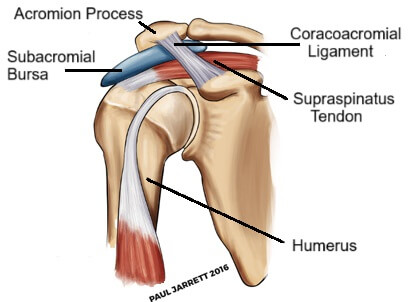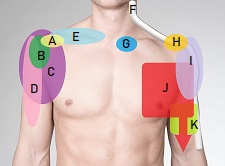- Home
- Common Shoulder Problems
- Bursitis
- Subacromial Bursitis
Subacromial Bursitis
Written By: Chloe Wilson BSc (Hons) Physiotherapy
Reviewed By: SPE Medical Review Board

Subacromial bursitis is a common cause of shoulder pain that gets worse when you raise your arm.
Irritation and inflammation in one of the fluid-filled sacs near the top of the shoulder results in pain, weakness and restricted shoulder motion.
Subacromial bursitis is typically an overuse injury caused by repetitive overhead movements. It is the most common type of shoulder bursitis.
Most cases settle with simple treatments such as rest, ice, medication and exercises while more persistent case may require subacromial bursitis injections or surgery.
Here we look at the shoulder anatomy and what subacromial bursitis is, common causes and symptoms, how it is diagnosed and the best treatment and prevention options.
Subacromial Bursa Anatomy
The subacromial bursa is the largest bursa found in the shoulder. A bursa is a small sac or pocket of synovial fluid that sits between bone and soft tissue to cushion and reduce friction.
The subacromial bursa is located between:
- Acromion Process: part of the scapula, and the coracoacromial ligament (above the bursa)
- Supraspinatus Tendon: one of the rotator cuff tendons, and the joint capsule (below the bursa)
The subacromial bursa helps to prevent friction at the shoulder, protect the joint capsule and reduce wear and tear of the supraspinatus tendon during arm movement.
The bursa also contains free nerve endings and nociceptors which can detect potentially harmful stimuli. If there is excess pressure, friction or irritation of the bursa, they send pain signals to the brain to help protect the area.
What is Subacromial Bursitis?
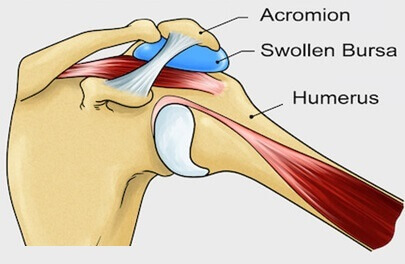
Subacromial bursitis is a painful condition that occurs when the subacromial bursa becomes irritated or inflamed, usually due to repetitive friction from overhead activities.
The bursa attempts to protect itself and the nearby structures by producing more synovial fluid, causing it to gradually swell.
Not only can this cause pain in the bursa itself, but the swelling can also irritate and put pressure on the surrounding soft tissues.
This can cause significant pain and limit the shoulder’s range of motion, especially during activities that involve lifting the arm.
Subacromial bursitis is a common cause of shoulder pain and can develop gradually over time or result from an acute injury. It often occurs in conjunction with other shoulder conditions, such as rotator cuff tendinitis or shoulder impingement, making diagnosis and treatment critical to restoring proper shoulder function.
Common Causes of Subacromial Bursitis
There are a number of things that can cause subacromial bursitis:
- Overuse and Repetitive Movements: activities that involve repeated overhead arm movements, such as painting, swimming, tennis, throwing sports or weightlifting, can place excessive strain on the shoulder and irritate the bursa.
- Shoulder Impingement: Subacromial bursitis is frequently associated with shoulder impingement syndrome, where the rotator cuff tendons and bursa become pinched or compressed between the acromion and the humeral head. Impingement often results from structural abnormalities, such as bone spurs, or from poor shoulder mechanics.
- Trauma or Injury: A direct blow to the shoulder, such as falling onto an outstretched arm or suffering a sports-related injury, can cause the bursa to become inflamed. Acute trauma can lead to sudden onset of bursitis, accompanied by swelling and pain.
- Degenerative Conditions: Aging and wear-and-tear conditions like osteoarthritis can make the bursa more susceptible to irritation and inflammation.
- Poor Posture: Slouching or having a forward head posture can increase the likelihood of shoulder impingement and bursa irritation. Poor posture alters the alignment of the shoulder joint, placing undue stress on the bursa and rotator cuff.
- Systemic Conditions: Certain medical conditions, such as rheumatoid arthritis, gout, or diabetes, can increase the risk of developing bursitis. These systemic conditions can lead to chronic inflammation, affecting multiple joints and bursae throughout the body.
- Anatomy: The shape and angle of the acromion can contribute to subacromial bursitis. The acromion may be flat (12%), curved (56%), hooked (29%) or convex/upturned (3%). Having a hooked acromion reduces the subacromial space, increasing the pressure on the bursa.
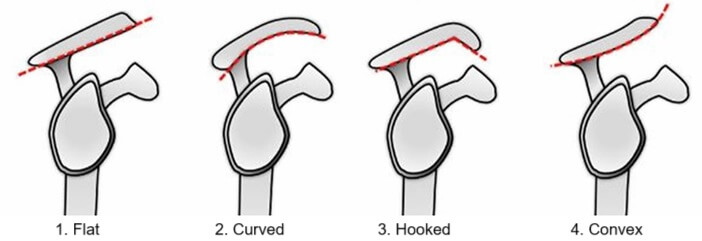
Symptoms of Subacromial Bursitis
The symptoms of subacromial bursitis can range from mild to severe and typically worsen with shoulder movement. Common signs and symptoms include:
- Shoulder Pain: Pain is the most prominent symptom of subacromial bursitis and is often felt at the top, front or outer side of the shoulder. It may start gradually or appear suddenly, depending on the cause. Subacromial bursitis pain is typically worse when lifting the arm above shoulder height, reaching behind the back, or lying on the affected side.
- Tenderness and Swelling: The shoulder may feel tender to the touch, and mild swelling may be present, particularly after a recent injury. The inflammation can cause the shoulder joint to feel warm or appear slightly red, although this is rare
- Limited Range of Motion: Inflammation of the bursa can restrict shoulder movement, making it difficult to perform everyday activities like reaching for objects, putting on clothes, or combing hair. The stiffness can be especially pronounced in the morning or after prolonged periods of rest.
- Weakness: Chronic pain and inflammation with subacromial bursitis can lead to weakness in the shoulder, affecting grip strength or the ability to lift objects. Weakness may be more noticeable during overhead activities or when trying to push or pull something.
- Night Pain: Many people with subacromial bursitis experience increased pain at night, especially when lying on the affected side. This can make sleeping difficult and contribute to fatigue.
Pain from subacromial bursitis tends to be fairly localised, it generally doesn’t refer below the shoulder unless there are other associated problems such as impingement syndrome or supraspinatus tendonitis.
Diagnosis of Subacromial Bursitis
Diagnosing subacromial bursitis typically involves a comprehensive evaluation by a healthcare professional, including a detailed medical history, physical examination, and in some cases, imaging tests:
Medical History
Your doctor will ask about your symptoms, including when the pain started, what makes it better or worse, and whether you have a history of shoulder injuries or overuse activities.
They will also inquire about your daily activities, posture, and any underlying health conditions that could contribute to the problem.
Physical Examination
The doctor will assess the range of motion and strength in your shoulder.
Resisted abduction (moving your arm out to the side against resistance) is usually painful with subacromial bursitis, particularly as the arm approaches shoulder height, as the bursa gets pinched. Active range of shoulder flexion, abduction and internal rotation is often reduced due to pain.
They may also perform specific tests to identify areas of tenderness, swelling, or impingement, such as:
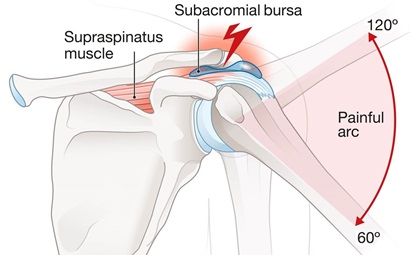
- Painful Arc Test: The doctor may ask you to raise your arm out sideways (abduction). Pain between 60°-120° of abduction is often a sign of subacromial bursitis and shoulder impingement.
- Neer’s Test: The doctor raises your arm while stabilizing your shoulder blade. Pain during this motion may indicate impingement or bursa irritation.
Imaging Tests
In most cases, your doctor can accurately diagnose subacromial bursitis from your history and physical exam, but you may be sent for imaging studies to rule out other shoulder problems.
- X-rays: While X-rays cannot show the bursa directly, they can help identify bone abnormalities, such as bone spurs or hooked acromion, which may be causing impingement or contributing to bursitis.
- Ultrasound: An ultrasound can provide a more detailed look at the soft tissues in the shoulder, helping to detect bursa thickening or inflammation and rotator cuff issues.
- MRI: An MRI may be used to evaluate the extent of inflammation or to rule out other conditions, such as rotator cuff tears or labral injuries, which may be causing your shoulder pain.
Differential Diagnosis
Other shoulder conditions that can present with similar symptoms to subacromial bursitis include:
- Shoulder Impingement Syndrome: pain and restriction from narrowing of the subacromial space
- Suprasinatus Tendonitis: Inflammation and irritation of one of the main shoulder tendons
- Biceps Tendonitis: Irritation and inflammation of the biceps tendon at the front of the shoulder
- Rotator Cuff Tear: a tear in one of the four main shoulder tendons
- Adhesive Capsuliutis: aka frozen shoulder
- Labrum Tear: tear in the ring of cartilage lining the shoulder joint
There are other types of arm and shoulder bursitis, the most common being scapulothoracic bursitis (at the shoulder blade) and olecranon bursitis (behind the elbow).
#CommissionsEarned from Amazon on qualifying purchases
Treatment for Subacromial Bursitis
Subacromial bursitis treatment typically focuses on relieving pain, reducing inflammation, and restoring shoulder function. The approach depends on the severity of the condition and whether it is acute or chronic. Subacromial bursitis treatment usually involves a combination of:
- Rest and Activity Modification: Avoiding activities that worsen the pain, such as lifting heavy objects or performing overhead movements and take breaks from repetitive tasks to prevent further irritation.
- Ice Therapy: Applying ice packs to the affected area for 15-20 minutes several times a day can help reduce swelling and numb the pain.
- Medications: Over-the-counter anti-inflammatory medications, such as ibuprofen or naproxen, can help manage pain and reduce inflammation.
- Physical Therapy: A structured physical therapy program can be highly effective in treating subacromial bursitis. A physical therapist will guide you through exercises to improve shoulder strength, flexibility, and posture. They may also use modalities like ultrasound therapy, heat, or electrical stimulation to aid recovery.
- Shoulder Exercises: Gentle stretching and strengthening exercises can help improve shoulder mobility and reduce the risk of recurrence. Exercises often focus on the rotator cuff muscles and scapular stabilizers to improve shoulder mechanics.
- Corticosteroid Injections: If shoulder pain persists despite conservative treatments, a corticosteroid injection into the subacromial bursa may be recommended. This can significantly reduce inflammation and pain, but the effects may be temporary. Repeated subacromial bursitis injections should be used cautiously, as they can weaken tendons over time.
Most cases of subacromial bursitis will settle down within 3-6 months when using these treatment methods and people typically regain full function in their shoulder.
Surgical Treatments
If symptoms fail to improve despite treatment, surgery may be recommended. Subacromial bursitis surgery is usually only necessary with more chronic cases or those with other associated shoulder problems such as impingement syndrome or bone spurs.
- Arthroscopic Bursectomy: Arthroscopic surgery is minimally invasive and involves using a small camera and instruments to remove the bursa and any bone spurs that may be contributing to impingement.
- Subacromial Decompression: This procedure involves reshaping or removing part of the acromion to create more space for the rotator cuff and bursa, reducing impingement and pressure. It is often performed alongside bursectomy if impingement is a significant factor. Find Out More >
Recovery from surgery may take several weeks, and physical therapy is essential to restore full shoulder function. Most people experience significant pain relief and improved shoulder mobility after appropriate treatment.
Summary
Subacromial bursitis is a common cause of shoulder pain, resulting from irritation and inflammation of the subacromial bursa.
It often develops due to repetitive overhead activities, trauma, or degenerative conditions and may be associated with shoulder impingement.
Common symptoms of subacromial bursitis include localised pain at the top, front or side of the shoulder, swelling, limited range of motion, and weakness, which can interfere with daily activities.
Subacromial bursitis treatment focuses on reducing pain and inflammation through rest, ice, medications, injections and physical therapy, with surgery as a last resort.
By practicing proper shoulder mechanics and strengthening the surrounding muscles, subacromial bursitis can be effectively managed and even prevented.
You may also be interested in the following articles:
Related Articles
Shoulder Problems
November 6th, 2024
Diagnosis Charts
February 11th, 2025
Rehab Exercises
December 12, 2023
Medical & Scientific References
- Subacromial Bursitis. National Library Of Medicine
- Subacromial Bursa: A Neglected Tissue Is Gaining More and More Attention in Clinical and Experimental Research. Cells Journal
- Acromial Types. Radiopaedia
Page Last Updated: November 6th, 2024
Next Review Due: November 6th, 2026
